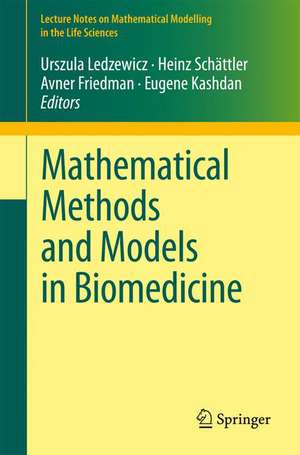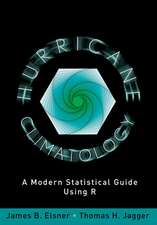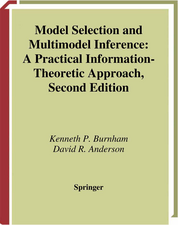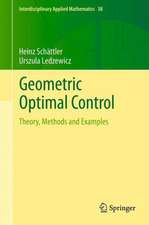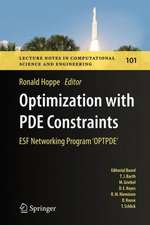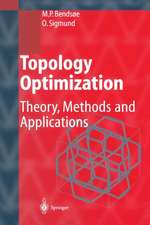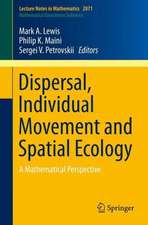Mathematical Methods and Models in Biomedicine: Lecture Notes on Mathematical Modelling in the Life Sciences
Editat de Urszula Ledzewicz, Heinz Schättler, Avner Friedman, Eugene Kashdanen Limba Engleză Paperback – 21 oct 2012
Din seria Lecture Notes on Mathematical Modelling in the Life Sciences
-
 Preț: 340.61 lei
Preț: 340.61 lei - 15%
 Preț: 496.23 lei
Preț: 496.23 lei - 15%
 Preț: 605.02 lei
Preț: 605.02 lei - 15%
 Preț: 422.82 lei
Preț: 422.82 lei - 15%
 Preț: 704.69 lei
Preț: 704.69 lei -
 Preț: 412.58 lei
Preț: 412.58 lei -
 Preț: 543.08 lei
Preț: 543.08 lei - 15%
 Preț: 643.95 lei
Preț: 643.95 lei - 15%
 Preț: 655.77 lei
Preț: 655.77 lei - 15%
 Preț: 474.31 lei
Preț: 474.31 lei - 18%
 Preț: 784.48 lei
Preț: 784.48 lei -
 Preț: 389.70 lei
Preț: 389.70 lei - 15%
 Preț: 586.64 lei
Preț: 586.64 lei - 15%
 Preț: 519.32 lei
Preț: 519.32 lei - 15%
 Preț: 587.85 lei
Preț: 587.85 lei -
 Preț: 401.42 lei
Preț: 401.42 lei -
 Preț: 456.48 lei
Preț: 456.48 lei -
 Preț: 379.09 lei
Preț: 379.09 lei - 15%
 Preț: 635.84 lei
Preț: 635.84 lei
Preț: 703.85 lei
Preț vechi: 828.05 lei
-15% Nou
Puncte Express: 1056
Preț estimativ în valută:
134.70€ • 146.26$ • 113.15£
134.70€ • 146.26$ • 113.15£
Carte tipărită la comandă
Livrare economică 22 aprilie-06 mai
Preluare comenzi: 021 569.72.76
Specificații
ISBN-13: 9781461441779
ISBN-10: 1461441773
Pagini: 440
Ilustrații: XI, 427 p. 94 illus.
Dimensiuni: 155 x 235 x 27 mm
Greutate: 0.61 kg
Ediția:2013
Editura: Springer
Colecția Springer
Seria Lecture Notes on Mathematical Modelling in the Life Sciences
Locul publicării:New York, NY, United States
ISBN-10: 1461441773
Pagini: 440
Ilustrații: XI, 427 p. 94 illus.
Dimensiuni: 155 x 235 x 27 mm
Greutate: 0.61 kg
Ediția:2013
Editura: Springer
Colecția Springer
Seria Lecture Notes on Mathematical Modelling in the Life Sciences
Locul publicării:New York, NY, United States
Public țintă
ResearchCuprins
Spatial aspects of HIV infection.- Basic Principles in Modeling Adaptive Regulation and Immunodominance.- Evolutionary Principles In Viral Epitopes.- A Multiscale Approach Leading to Hybrid Mathematical Models for Angiogenesis: the Role of Randomness.- Modeling Tumor Blood Vessel Dynamics.- Influence of Blood Rheology and Outflow Boundary Conditions in Numerical Simulations of Cerebral Aneurysms.- The Steady State of Multicellular Tumour Spheroids: a Modelling Challenge.- Deciphering Fate Decision in Normal and Cancer Stem Cells – Mathematical Models and Their Experimental Verification..- Data Assimilation in Brain Tumor Models.- Optimisation of Cancer Drug Treatments Using Cell Population Dynamics.- Tumor Development under Combination Treatments with Antiangiogenic Therapies.- Saturable Fractal Pharmacokinetics and Its Applications.- A MathematicalModel of Gene Therapy for the Treatment of Cancer.- Epidemiological Models with Seasonality.- Periodic Incidence in a Discrete-Time SIS Epidemic Model.
Textul de pe ultima copertă
Mathematical biomedicine is a rapidly developing interdisciplinary field of research that connects the natural and exact sciences in an attempt to respond to the modeling and simulation challenges raised by biology and medicine. There exist a large number of mathematical methods and procedures that can be brought in to meet these challenges and this book presents a palette of such tools ranging from discrete cellular automata to cell population based models described by ordinary differential equations to nonlinear partial differential equations representing complex time- and space-dependent continuous processes. Both stochastic and deterministic methods are employed to analyze biological phenomena in various temporal and spatial settings. This book illustrates the breadth and depth of research opportunities that exist in the general field of mathematical biomedicine by highlighting some of the fascinating interactions that continue to develop between the mathematical and biomedical sciences. It consists of five parts that can be read independently, but are arranged to give the reader a broader picture of specific research topics and the mathematical tools that are being applied in its modeling and analysis. The main areas covered include immune system modeling, blood vessel dynamics, cancer modeling and treatment, and epidemiology. The chapters address topics that are at the forefront of current biomedical research such as cancer stem cells, immunodominance and viral epitopes, aggressive forms of brain cancer, or gene therapy. The presentations highlight how mathematical modeling can enhance biomedical understanding and will be of interest to both the mathematical and the biomedical communities including researchers already working in the field as well as those who might consider entering it. Much of the material is presented in a way that gives graduate students and young researchers a starting point for their own work.
Caracteristici
The book illustrates the depth and breadth of research opportunities that exist in the field of mathematical biomedicine The chapters can be read independently and show how mathematical modeling can enhance biomedical understanding and provide tools for biomedical research The book illustrates the fascinating interactions that continue to develop between the mathematical and biomedical sciences Includes supplementary material: sn.pub/extras
